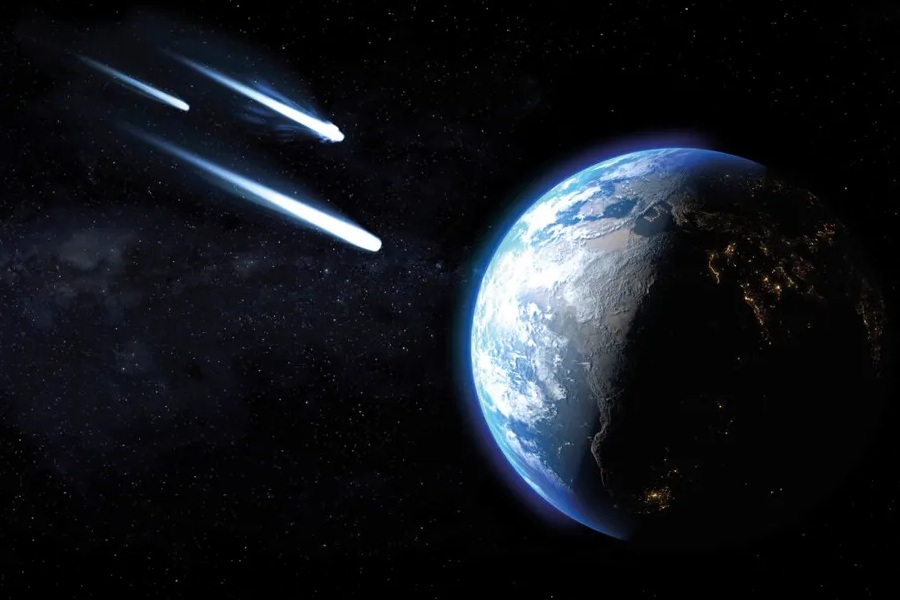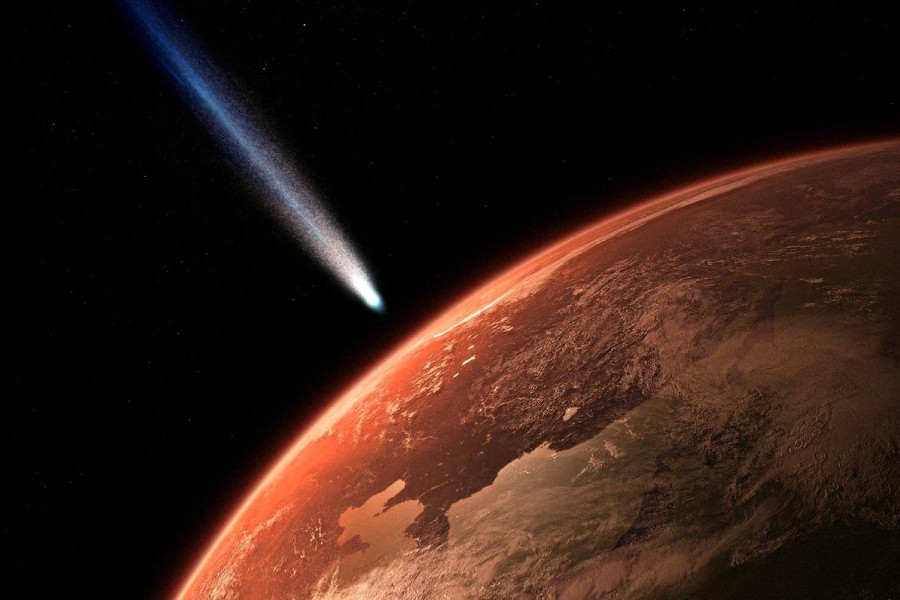Our Solar System is home to many icy objects that develop long, glowing tails as they approach the Sun. These objects are known as comets. But how many comets are in our Solar System?
It’s a difficult question to answer precisely, as new comets are constantly being discovered while existing ones fade from view. Yet, astronomers have developed methods to estimate the total comet population based on the number observed over time.
So, we’ll explore what defines a comet, discuss the challenges in spotting and tracking them, and review the techniques astronomers use to estimate the total population. We’ll also provide the latest numbers on how many icy wanderers our Solar System contains.

How Many Comets Are in Our Solar System?
Astronomers believe our Sun is surrounded by billions of comets, based on their discovery statistics and calculations of a comet’s typical lifespan. Comets originate from two cold storage regions in our Solar System: the Kuiper Belt and the Oort Cloud.
The Kuiper Belt starts beyond Neptune’s orbit and stretches to about 50 astronomical units from the Sun. In comparison, the Oort Cloud is much more distant, ranging from 2,000 to 100,000 astronomical units away.
But how many comets are there? So far, there are around 4,000 comets discovered. Nevertheless, this number is expected to rise steadily as more advanced telescopes detect faint and distant comets in the outer Solar System. While the exact count remains elusive, our Solar System might have over one billion comets.
The Challenge of Quantifying Comets
Comets are found in the farthest regions of the Solar System and usually move in unusual paths around the Sun. Due to their extended orbital periods and paths that take them far from us, many comets go unnoticed from Earth.
Determining precise total numbers involves addressing the challenges of our observations. This is because the current search efforts have only detected a certain percentage of comets, making it difficult to provide an accurate estimate.
Importance of Understanding Their Diverse Characteristics and Orbits
Comets come in different sizes, shapes, compositions, and orbits, showcasing a fascinating diversity. Studying these variations helps us understand the conditions and dynamics of the early Solar System.
To grasp why comets look different and follow distinct paths, it’s essential to consider their origins. We can trace their ancestral migration within the Sun’s sphere of influence by examining their precise trajectories. This mapping provides valuable insights into the history and evolution of these celestial objects.
Comets’ Characteristics
Unveiling the structure
Nuclei
Comet nuclei, the solid cores of cosmic snowballs, are small icy bodies, usually just a few miles across. These nuclei consist of frozen volatiles, dust, and rocks.
They vary widely in size, ranging from a few hundred meters to over 30 miles across. Larger nuclei likely indicate older comets that have endured repeated close encounters with the Sun throughout their lengthy orbital history.
As these nuclei approach the Sun, the absorption of light and heat triggers significant outgassing activity. The intensity of this outgassing varies in different regions, influenced by factors such as chemical composition and depth beneath the surface. Also, active vents and pits release ice, gases, and dust jets, forming comets’ distinctive coma and tails.
Coma
The coma creates a cloudy, round atmosphere that surrounds its nucleus. The nucleus heats up when a comet gets closer to the Sun along its orbit. This heat causes the nucleus to forcefully release dust and gases, spreading over thousands or even millions of kilometers.
In many cases, this released material may seem larger than the Sun when observed from Earth. This expanding combination of dust and gases forms the hazy coma that surrounds the bright nucleus of a comet.
The coma undergoes dynamic changes as the outflowing material interacts with solar emissions. The solar wind and radiation pressure push this mixture into long, striking ion and dust tails that trail behind the comet for vast distances. As the heating cycles continue, more ejections occur, spectacularly enhancing the comet’s visibility.

Composition essentials
Ice
Comets are made up of a lot of water, ice, and other frozen substances like carbon dioxide, carbon monoxide, methane, and ammonia. When the core of a comet heats up, these unusual ices start turning into gas without becoming liquid first.
As the ice below the surface turns into gas, it creates pressure, and the gases burst out forcefully through openings, carrying dust with them. This causes the distinctive outflow activity we see, as the release of stored frozen substances plays a significant role in this phenomenon.
Dust
Microscopic dust is a key element found in both the nucleus and the coma and tails of comets. Scientists have identified silicates, carbonaceous compounds, and minerals by analyzing comets’ particles. Notably, these components bear a striking resemblance to the dust samples obtained from asteroids and interstellar space.
This evidence supports the notion that comets harbor primordial ingredients left over from the early stages of Solar System formation. These ingredients have been preserved in deep, cold storage for billions of years.
Gasses
As icy material turns into gas through sublimation, it forms expanding atmospheres around comets known as comae. They are mainly composed of water vapor and small amounts of carbon dioxide, carbon monoxide, molecular oxygen, sulfur compounds, formaldehyde, and cyanides such as hydrogen.
As comets move closer to the Sun along their orbit, the rates at which materials are released and their precise composition change dynamically. More intense jet eruptions occur near perihelion, the point in the orbit closest to the Sun. These eruptions release larger amounts of water vapor, carbon dioxide, and other volatile substances.
Organic materials
Comets have a variety of organic chemicals, such as alcohols, carboxylic acids, amines, and hydrocarbon chains found in samples. More complex prebiotic molecules, like amino acids and nucleotide bases, are also believed to be present.
These complex organic compounds could have played a role in the initial biochemical steps that led to the origins of life on early Earth and other developing worlds. This is because they delivered ingredients that supported and facilitated the emergence of prebiotic chemistry.
Orbit Periods and Elliptical Orbits
Understanding orbit periods
Comets travel in orbits around the Sun, with durations ranging from a few years to millions of years. Some comets, known as short-period comets, finish their orbits in less than 200 years.
On the other hand, long-period comets take more than 200 years to complete their journey. The way comets act is influenced by their position along the orbital path, particularly during their closest approach to the Sun, known as perihelion.
As comets get closer to the Sun, they experience increased exposure to solar heating. This heightened exposure affects their activity levels and compositions.
Specifically, when comets approach perihelion, the intensity of solar heating rises, causing them to become more active. This increased activity leads to the ejection of greater amounts of gas and dust, making the comets more visible to observers.
Emphasizing elliptical paths
Comets travel in elliptical orbits, which means their paths around the Sun can be more stretched out or compact. Some orbits are highly elongated, taking comets close to and far from the Sun. When comets are on highly elliptical orbits, they venture into the chilly outer regions, where the Sun’s impact is minimal until they dive back inward.
The way orbits are shaped and positioned influences the routes comets take in space. It also affects how easily we can observe them from Earth at various points along their journey.

Types of Comets in Our Solar System
Short-period comets
Short-period comets complete their orbits in less than 200 years; some even make the journey in just 2-20 years. The gravitational pull of giant planets plays a crucial role in shaping their trajectories, forming comet families and clusters.
An excellent illustration of this phenomenon is Halley’s comet, which graces the Earth with its presence every 75-76 years. The comet changes surface activity as it comes close to the sun during these near passes, making it a widely observed celestial event.
By closely examining comets that frequently return, scientists gain valuable insights into how their compositions are modified through repeated close encounters with the Sun. This process involves gradually losing volatile materials, driven by progressive heating cycles over time.
Comparing freshly arrived comets to those undergoing multiple solar passes helps researchers map out the evolutionary effects on these celestial bodies. This detailed analysis sheds light on the intricate transformations that comets undergo as they navigate the Solar System.
Long-period comets
Comets with enormous orbital periods exceeding 200 years are classified as long-period and originate from the vast Oort Cloud surrounding our Solar System. Only rarely perturbed inward towards the Sun, these pristine remnants represent leftover building blocks unchanged since formation over four billion years ago.
By studying their unique chemistry and characteristics, we gain valuable insights into the early ingredients of the Solar System. These comets offer a glimpse into the formation dynamics from a source that has remained relatively unchanged. Due to their distant origins and infrequent appearances, opportunities to analyze them are rare and precious.
Conclusion
How many comets are in our Solar System? As stated, there are around 4,000 so far. Yet, the exact number of comets remains elusive because residents in distant, densely populated regions are hidden from our view.
Nevertheless, uncovering the secrets of their formation and evolution highlights the broader significance of solving the mysteries surrounding these objects throughout the vast outer solar system.
By exploring the difficulties in counting comets and the methods we use to estimate their populations, we aim to deepen your understanding and appreciation for these dynamic celestial bodies and the importance of grasping their diversity.
